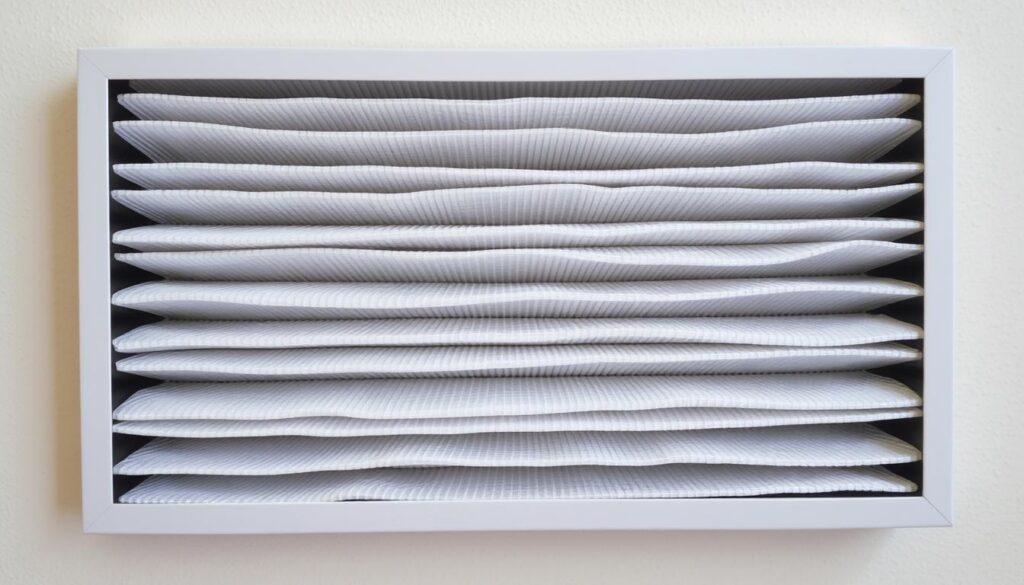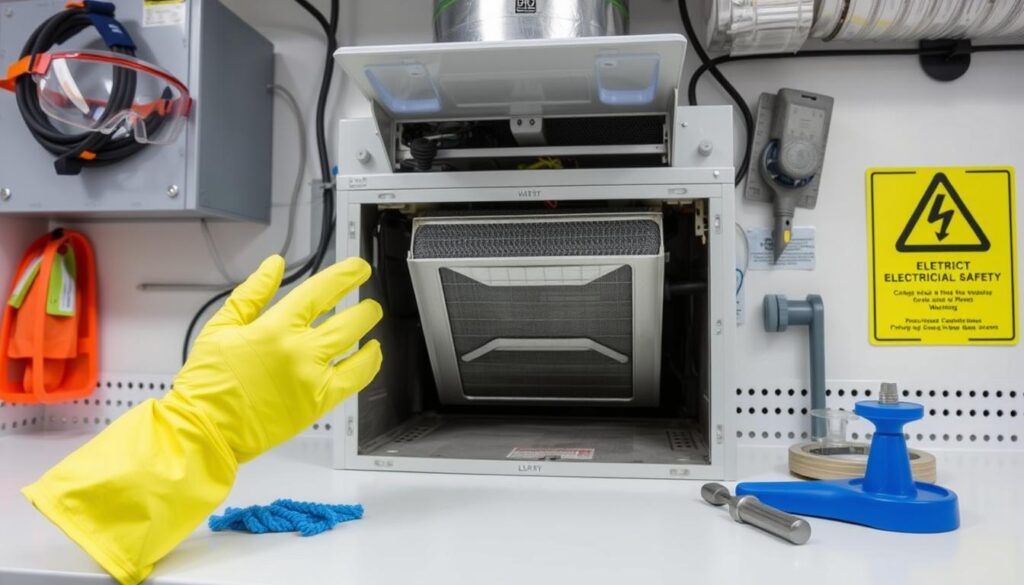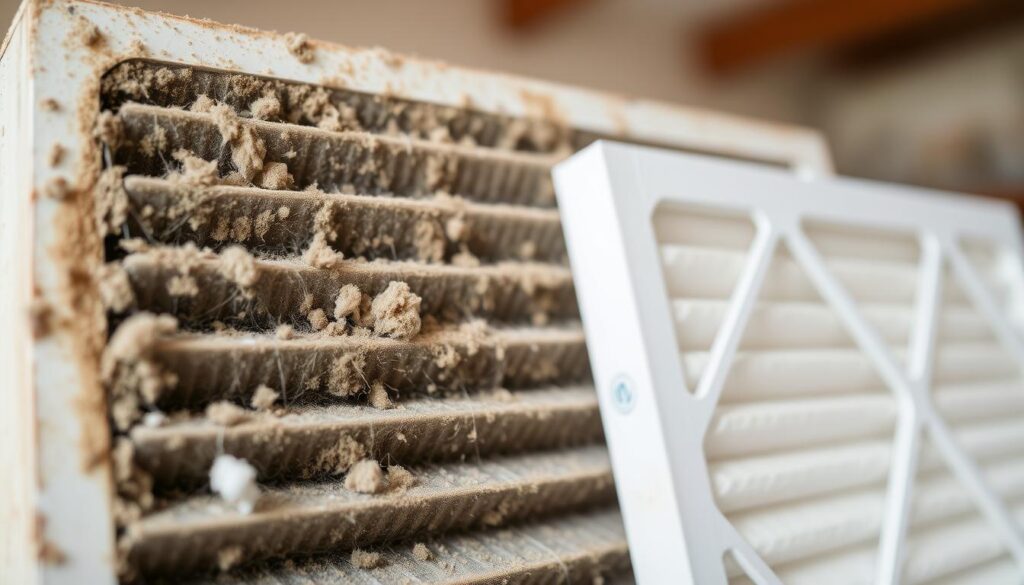Affiliate Disclosure
HVAC Guide Guys is a participant in the Amazon Services LLC Associates Program, an affiliate advertising program designed to provide a means for sites to earn advertising fees by advertising and linking to Amazon.
Can You Change HVAC Filter Yourself? Did you know that not changing your HVAC filter can increase your energy bills by up to 15%? Keeping your HVAC filter clean is key to good indoor air, a longer-lasting furnace, and lower energy use. This guide will show you how to easily find, take out, and put in your HVAC filters. This way, your home stays comfy and energy-efficient.

Key Takeaways
- Regular HVAC filter replacement is essential for improving indoor air quality and reducing energy costs.
- Identifying the correct filter size is crucial for ensuring proper HVAC system performance.
- Turning off power to the HVAC system before changing filters is recommended for safety.
- Proper filter installation techniques are vital for optimal airflow and system efficiency.
- Frequent filter changes (every 1-3 months) may be necessary, depending on environmental factors.
Table of Contents
Understanding the Importance of HVAC Filter Maintenance
Keeping your HVAC system’s air filters clean is key for good indoor air quality and energy efficiency. Clean filters catch dust, allergens, and pollutants, making the air in your home healthier. If you ignore filter maintenance, your HVAC system might not last as long, use more energy, and cost more to run.
Impact on Air Quality and Energy Efficiency
Dirty air filters block airflow, making your HVAC system work harder. This not only lowers its energy efficiency but also shortens its life. Regularly changing your air filters keeps your home comfortable and your energy bills down.
Benefits of Regular Filter Replacement
- Improved indoor air quality by trapping more airborne particles and allergens
- Enhanced energy efficiency and reduced utility bills
- Prolonged HVAC system lifespan by reducing strain on the equipment
- Better overall system performance and fewer unexpected breakdowns
Cost Savings from DIY Maintenance
Changing your HVAC air filters is easy and can save you money. Doing it yourself can cut down on service costs and make your HVAC system last longer. This leads to big savings over time.
| Filter Replacement Frequency | Estimated Energy Savings |
|---|---|
| Every 30-60 days | 5-15% improvement in efficiency |
| Every 3 months | $9-$22 per month in energy cost savings |
By focusing on HVAC filter maintenance, you get cleaner air, better energy use, and a longer HVAC system lifespan. Regular DIY filter changes also save you money in the long run compared to hiring professionals.
Explore Our HVAC Shop
Looking for top-rated HVAC tools, parts, and accessories? Visit our shop and find the perfect solution for your needs.
Visit the ShopLocating Your HVAC Filter
First, find where your HVAC filter is to keep your heating and cooling system running well. Filters are usually in the return air duct, air handler cabinet, or blower compartment.
The return air duct draws air back into the system. It’s often near the air handler unit or behind a wall-mounted register. The air handler cabinet, which has the blower fan, is another spot. Filters can also be in the blower compartment, after removing the front panel.
In some homes, there are multiple filter spots. Check your system well. Filters might be in ceiling grilles, wall vents, or inside the HVAC unit, often in closets. For window units, the filter is behind the front panel.
If you’re not sure where your filter is, check your system’s manual or search online. Knowing where your filter is helps you replace it on time. This keeps your HVAC filter location, return air duct, and air handler cabinet in top shape.
| HVAC Filter Location | Description |
|---|---|
| Return Air Duct | Filters are commonly placed in the return air duct, which draws air back into the HVAC system. |
| Air Handler Cabinet | Filters may be located within the air handler cabinet, which houses the blower fan and other key components. |
| Blower Compartment | Filters can also be found in the blower compartment, accessible by removing the front panel of the HVAC unit. |
Finding your HVAC filter’s spot is key for good maintenance. It helps improve air quality, saves energy, and makes your system last longer.
Essential Tools and Materials Needed
Changing your HVAC filter is easy and can greatly improve your home’s climate control. You’ll need a few basic tools and materials to start.
Required Equipment for Filter Change
- Screwdriver – A basic flathead or Phillips head screwdriver is necessary to access the filter compartment.
- Measuring Tape – Knowing the exact dimensions of your existing HVAC filter is crucial to selecting the right replacement.
Types of HVAC Filters Available
HVAC filters vary in size, material, and style. They fit different systems and needs. Disposable filters are common and need to be replaced every 1-3 months. Reusable filters can be washed and reused for years.
Understanding MERV Ratings
When picking an HVAC filter, look at the MERV (Minimum Efficiency Reporting Value) rating. It ranges from 1 to 20, with higher numbers filtering smaller particles better. Most homes use filters with MERV ratings between 8 and 13 for good balance.
With the right tools, materials, and knowledge of filter types and MERV ratings, you can easily change your filter. This keeps your home’s climate control system working well.
Safety Precautions Before Starting
Before you start changing your HVAC filter, safety is key. You need to focus on HVAC safety and electrical safety. This is to avoid any dangers or harm to your system.
First, turn off your HVAC system. This stops debris from getting in and keeps electrical safety in check. For central air, switch off the power at the thermostat or circuit breaker. If you have a window unit, just unplug it.
- Wear protective gloves to keep your hands safe from dust and allergens.
- Make sure you have good lighting and a stable, secure place to work.
- If you’re not sure about any step, it’s wise to ask a professional HVAC technician. This helps avoid damage to your system.
Keeping your HVAC system’s electrical safety and shutting it down before changing the filter are key steps. By doing this, you can avoid HVAC safety problems and keep your system working well.

“Proper maintenance and precautions can significantly extend the lifespan of your HVAC system and keep your home comfortable year-round.”
Explore Our HVAC Shop
Looking for top-rated HVAC tools, parts, and accessories? Visit our shop and find the perfect solution for your needs.
Visit the ShopCan You Change HVAC Filter Yourself: Step-by-Step Process
Keeping your HVAC system healthy is key for good heating and cooling. It also helps improve the air you breathe indoors. Wondering if you can change your HVAC filter yourself? Yes, you can! It’s a simple task that you can do yourself with a few easy steps.
Removing the Old Filter
The first thing to do is find the filter housing. It’s usually near the return air duct or blower. Open the panel or grille to get to the old filter. Take note of its size and the airflow arrows’ direction when you remove it.
Cleaning the Filter Area
Before putting in the new filter, clean the area. Use a damp cloth to wipe down the surfaces. This removes dust and debris, helping the new filter work better.
Installing the New Filter
After cleaning, it’s time for the new filter. Make sure the airflow arrows point towards the HVAC unit. Slide the filter in gently, ensuring it fits well. Then, close the panel or grille and turn the system back on.
By following these DIY filter replacement steps, you keep your HVAC system running smoothly. It ensures your system works well and maintains clean air.
“Proper HVAC filter installation and replacement can prevent issues such as poor airflow, decreased HVAC efficiency, higher monthly bills, and dirty air throughout the home.”
Proper Filter Installation Techniques
Installing your HVAC filter right is key for keeping your system running well and the air clean. Always check the filter orientation, airflow direction, and filter sizing when you replace it.
The arrows on the filter show where the air should flow. If you put it in the wrong way, it can block airflow. Also, the filter must fit tightly to stop unfiltered air from getting through.
| Filter Orientation | Airflow Direction | Filter Sizing |
|---|---|---|
| Ensure the filter is installed with the airflow arrows pointing towards the HVAC unit or ductwork. | The filter should be oriented to allow air to flow through it in the correct direction, as indicated by the arrows. | Use the correct filter size for your HVAC system to ensure a proper fit and maximum efficiency. Measure the existing filter before purchasing a replacement. |
For pleated filters, the pleats should go up and down. This setup increases the filter’s surface area. It also helps capture more dust and keeps the air moving well in your space.
By installing your filter correctly, you can keep your HVAC system healthy. This improves the air quality indoors and might even lower your energy bills.
Explore Our HVAC Shop
Looking for top-rated HVAC tools, parts, and accessories? Visit our shop and find the perfect solution for your needs.
Visit the ShopMaintaining Different Types of HVAC Systems
Keeping your HVAC system’s air filters clean is key for top performance and energy savings. It doesn’t matter if you have a central central AC maintenance, a window unit, or a mini-split system care. Knowing the right filter for your system can really help.
Central Air Systems
Central air systems have filters in the return air duct or air handler. You should change these filters every 1-3 months. This depends on your household size, pets, and local air quality. Regular central AC maintenance keeps your air clean and your system running well.
Window Units
Window air conditioners have filters behind the front panel. These window AC filters need a monthly clean when you use them a lot. If you don’t, your cooling won’t be as good and you’ll use more energy.
Split Systems
Mini-split or ductless systems have filters in both units. You might need to clean or replace these mini-split system care filters every month. Check your system’s manual for the best care and filter types.
Regardless of your HVAC system, keeping filters clean is crucial. It helps keep your air clean, saves energy, and extends your system’s life. By taking care of your filters, you’ll enjoy a more comfortable and affordable home.
Troubleshooting Common Filter Issues
Keeping your HVAC system running well is key, and that starts with good air filter care. Even with regular checks, problems like clogged filters and performance issues can still happen. Knowing how to spot and fix these issues can keep your home comfy and save energy.
Signs of a Clogged Filter
- Reduced airflow throughout your home
- Increased energy bills due to the HVAC system working harder
- Poor indoor air quality and musty odors
Improper Filter Size or Fit
Using the wrong size filter can let unfiltered air through. Always measure your filter size right and choose the correct replacement.
Incorrect Filter Installation
Putting in the filter wrong can cause problems like it collapsing or damage to your HVAC. Always follow the manufacturer’s guide and make sure it’s installed right.
If you hear odd noises, smell something off, or notice your HVAC isn’t working as well after changing the filter, check it again. If problems keep happening, get help from a pro. Fixing these issues quickly is important for your HVAC’s health and efficiency.
| Common HVAC Filter Issues | Potential Causes | Signs to Look For |
|---|---|---|
| Clogged Air Filters | – Dirt, dust, and debris buildup – Neglecting regular filter changes | – Reduced airflow – Increased energy bills – Poor indoor air quality |
| Improper Filter Size/Fit | – Incorrect filter measurements – Trying to use the wrong size filter | – Unfiltered air bypassing the filter – Decreased HVAC efficiency |
| Incorrect Filter Installation | – Improper positioning or orientation – Damaged or collapsed filter | – Unusual noises from the HVAC system – Decreased system performance |
By knowing about these common filter problems and acting fast, you can keep your HVAC system running smoothly. This helps keep your air clean and saves energy in your home.

“Regularly changing your air filter can potentially save up to 15% on utility costs,” according to the Department of Energy.
Explore Our HVAC Shop
Looking for top-rated HVAC tools, parts, and accessories? Visit our shop and find the perfect solution for your needs.
Visit the ShopFilter Replacement Schedule and Maintenance Tips
Keeping your HVAC system in top shape starts with regular filter changes. Experts say to swap out your filters every 1 to 3 months. But, how often you need to do this can change based on a few things. These include the season, where you live, and how well the filter is doing.
Seasonal Considerations
In the hottest or coldest months, your HVAC system works harder. This means you might need to change filters every month. It’s because more air is moving, picking up dust, pollen, and other stuff.
Environmental Factors
If you have pets, smoke, or live in a polluted area, you’ll need to change filters more often. Allergens, dust, and other pollutants can quickly fill up the filter. This makes it less effective at cleaning the air.
Filter Life Indicators
Some filters have built-in indicators to tell you when it’s time for a new one. Look for color-coded strips or digital displays. Also, check the filter for any signs of dirt or discoloration. This helps keep your HVAC system running well and your air clean.
Sticking to a regular filter replacement schedule is key. It keeps your HVAC system running efficiently and improves the air in your home. By changing filters regularly, you can save money on energy bills and extend the life of your HVAC system.
| Home Scenario | Recommended Filter Replacement Frequency |
|---|---|
| Standard Homes | Every 90 days |
| Homes with Pets | Every 60 days |
| Homes with Allergy Sufferers | Every 20-45 days |
“Properly maintained air filters can help keep the HVAC system running smoothly, efficiently, and may reduce the need for frequent service calls.”
Conclusion
Changing your HVAC filter is easy and very important. It greatly affects your home’s air quality and energy use. Regular maintenance makes your HVAC system last longer, saves money on energy, and improves air inside your home.
By following the steps in this guide, you can change your HVAC filter yourself. This saves you money on professional services and keeps your system running well.
It’s key to replace filters regularly, based on your home’s needs. Clean and well-maintained filters are crucial for good air quality, saving energy, and a long-lasting HVAC system. With a bit of DIY work, your home will stay comfy and energy-efficient all year.
Air filters are very important for your home’s energy use and air quality. Changing them often brings many benefits. You’ll get cleaner air, lower energy bills, and a more efficient heating and cooling system.

